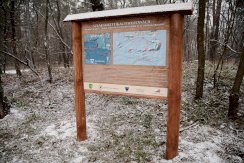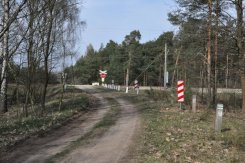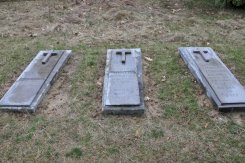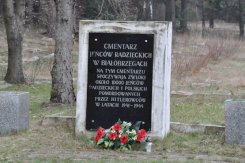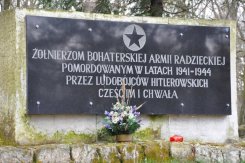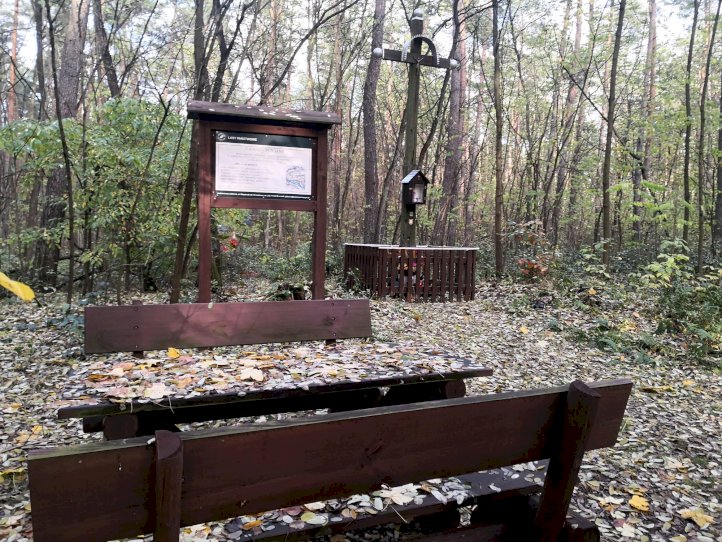
In the area around this crossroads, on both sides of the path, stood the buildings of Trzciany Manor Farm, which in August 1920, shortly before the Battle of Warsaw, hosted many units of the Polish Army, as well as officers of the French Military Mission—advisers to the staff of the 5th Army. Among the units mentioned in documents were: the command of the Nowy Dwór Front, the 1st Chevau-légers Regiment of Józef Piłsudski (most likely after the famous charge at Arcelin), the 2nd Battery of the 18th Borderland Field Artillery Regiment (mistakenly referred to in the document as the 18th Polish-Belarusian Artillery Regiment), the 1st Army Field Gendarmerie, Sector I, the 9th Telegraph Company, an Epidemic Column, and the machine gun company of the Kovno Rifle Regiment.
The first known mention of Trzciany Manor Farm dates back to 1847—it appears in a parish register of Nowy Dwór Mazowiecki. The place is also indirectly linked to the January Uprising. One of its participants, Jan Grąbczewski, after the fall of the insurrection, was stripped of his estate by the Tsarist authorities and settled in Trzciany. His sons, Konstanty and Franciszek, leased the manor farm.
In 1932, Jan’s grandson, Captain Czesław Grombczewski, graduated first in his class from the Reserve Artillery Cadet School in Volodymyr-Volynskyi. During the war he fought against both the German and Soviet invaders, ending his combat trail on October 5, 1939, in the Battle of Kock. In the resistance, he took the pseudonym “Jurand.” He was killed on July 13, 1944, in the battle near Krawczuny–Nowosiółki, while leading the 1st Vilnius Brigade of the Home Army.

Between 1887 and 1915, in the area of today’s Janówek Pierwszy, Janówek Drugi, and Trzciany, Tsarist sappers built a system of permanent and field fortifications—the Janówek Fortress Group. It formed part of the outer defensive ring of the Novogeorgievsk (Modlin) Fortress. The Strongpoint No. 10 fortification complex served as the southern wing of the Janówek Fortress Group. This complex included Strongpoint No. 10 (a concrete barracks shelter reinforced with field fortifications) as well as two 4-gun batteries of heavy artillery with field shelters for their crews.
In 1915, during World War I, Strongpoint No. 10 was manned by soldiers of the 19th Company of Novogeorgievsk Fortress Artillery, while their rear base in Boża Wola housed the staff and a detachment of the 626th Tambov Militia Unit. The heaviest fighting for the Modlin Fortress in August 1915 took place in the Pomiechówek sector. The Janówek Fortress Group was besieged by the German 169th Landwehr Brigade. Upon hearing of the surrender of the Novogeorgievsk Fortress, Russian soldiers blew up almost all of the permanent fortifications. Their picturesque ruins have survived to this day. Relatively well-preserved remains of the field fortifications can also still be admired.
The trail was prepared by the Historical-Research Association Triglav, in cooperation with the Jabłonna Municipality, the Jabłonna Forest District, and Res Publica Trzciany.
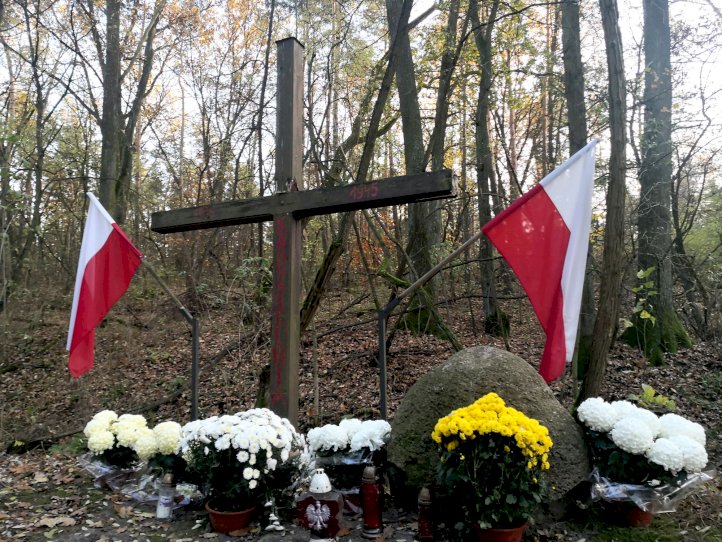
During the occupation, in the nearby hollows and depressions, the Germans executed Polish prisoners. Testimonies of the local population bear witness to these events, partially confirmed through investigations by the Institute of National Remembrance (IPN). Work to uncover the full picture of the tragic events that took place in Kadzielnia is still ongoing.
The IPN has established that on January 25–26, 1940, the Germans murdered “an undetermined number of victims” at this site. Evidence is still being examined to confirm whether executions of Poles had already taken place in Kadzielnia as early as 1939. Among those believed to have perished here were residents of Nowy Dwór Mazowiecki and Zakroczym (including Mayor Tadeusz Hanzlik), and possibly also prisoners from Warsaw’s Pawiak prison. Testimony given by Alma Majert indicates that Kadzielnia was also used by the Germans for carrying out Aktion T4, which the National Socialists described as the extermination of “life unworthy of life”—people with mental and physical disabilities.
One of the formations implementing this brutal plan was the Gestapo. The extermination of the population was actively supported by some members of the local community of German descent, who had lived in the area before the war and knew very well which Poles displayed especially patriotic attitudes.

In mid-August 1915, the fortress in Modlin was surrounded by German troops. The positions in front of the fort in Janówek were captured by the soldiers of the 169th Landwehr Brigade who gradually pushed their way towards the fortification. On hearing the news that the Germans captured the Pomiechówek sector and that the surrender of the fortress was signed, its defenders blew up the fort in Janówek.



Today we are solemnly reminded of these events thanks to the Monument to the fallen, erected by the inhabitants of the Janówek commune, with the commemorative stone plaque that reads: In memory of the Fallen at the border between the General Government and the Third Reich (Krubin - Olszewnica Nowa) and on the fronts of World War II. Another inscription reads: Who raises their hand against somebody, raises their hand agains God – John Paul II. The memorial plaque lists the names of the dead.

This monument was originally established and unveiled in Krubin, on the 15th anniversary of Poland’s recovery of sovereignty. During the war in 1939, it was destroyed by the Germans and only after Poland recovered its sovereignty, thanks to the efforts of the residents of Krubin and with the support and assistance of local authorities, the monument was reconstructed and placed in 2006 next to the church in Janówek Pierwszy.

In 1795, the estate in Góra was acquired by the chamberlain and President of the Senate of the Duchy of Warsaw, Ludwik Szymon Gutakowski. As president of the Economic and Agricultural Society, he ran in Góra a very modern arable farm.
The next owner of the estate was Count Wacław Gutakowski (1790-1882), officer of the Army of the Duchy of Warsaw, who took part in the 1809 and 1812-1813 campaigns. In 1811, he was an officer of the staff of Prince Józef Poniatowski and in February 1813 he was promoted to the rank of colonel of the 13th Hussar Regiment.
The 20th century was not a happy period for the palace in Góra. The neighbourhood Modlin Fortress and the forts in Janówek exposed it to the danger of bombings in 1915. During the interwar period, in the reconstructed and restored palace, there was a Female Agricultural School. Unfortunately, during the Second World War, the palace was burned and has never been rebuilt. This decent-size structure could not resist the passage of time and the systematic devastation of the post-war era.

The residents of Olszewnica played a significant role in Poland’s recovery of sovereignty. A local military sub-unit of the Polish Military Organization took part, in November 1918, in disarming the German garrison stationed in the barracks nearby the railway station Jabłonna (today Legionowo). The platoon was commanded by Jan Trzaskoma (1897-1943), who later participated in the 1920 Polish-Soviet War and was awarded the Silver Cross of the War Order of Virtuti Militari, in 1924, was consecrated as a priest. Some other key figures involved in the Polish Military Organization were: Wacław Sokulski and Stefan Cieśliński from Olszewnica, Trybulski and Afek from Krubin and the Kałęcki brothers, Leonard and Czesław from Skrzeszew.
In 1939, the head of the rural commune Olszewnica Stara, Piotr Sierawski, fearing the Germans dismantled the memorial plaque and buried it in his backyard. After the political changes at the beginning of the 90s of the 20th century, thanks to the efforts of Franciszek Jędraszko, a distinguished Polish Home Army soldier, the plaque was found and placed back on the monument, which was officially unveiled on August 15, 1991.



The two-way airport in Poniatów bore the code name “Żyto” (‘Rye’), as opposed to the more distant diversion airport in the direction of Łajski, code-named “Lasek” (‘Small wood’). During the air combat, on 1 September 1939, the commander of the 123rd Fighter Squadron, captain-pilot Mieczysław Olszewski, whose plane went down in Stanislawów near Legionowo, was killed. Those who suffered injuries were: pilot officer Feliks Szyszka and officer cadets Jerzy Radomski and Anthony Danek, who died from injuries on March 18, 1940. After the IV/1 Squadron of the Pursuit Brigade left Poniatów, on 5-7 September, the Poniatów airport was used by the Air Force of the “Modlin” Army: 152nd Fighter Squadron and 53rd Observation Squadron.

During World War II, the Poniatów home farm was governed by German extraordinary administration rules. The sister of the estate owner’s wife – Helena Soltan, who lived in Poniatów, recalls the manor house during the war in such words:
The manor, with so special population composition, was the scene where the issues of the Home Army from the entire region were concentrated, Military Service for Women (press distribution to military companies, supply of sanitary materials) and, after the liquidation of the ghetto in Legionowo (late October 1942) two adult women and two Jewish girls were kept hidden for seven months. In 1944, one of the girls, thanks to a very complex and meticulously prepared operation, were placed in a Catholic orphanage run by the Sisters of the Family of Mary in Płudy outside Warsaw.
The rooms on the first floor were occupied by German soldiers, some of whom were convalescents, who served as guards of the nearby border with the Reich, and supervised the Soviet prisoners of war from the camp in Beniaminów working on the farm.
In Poniatów, there were also the headquarters of the 8th Company of the Third Home Army Battalion, with its commander Władysław Danielewicz alias Oko (‘Eye’), second lieutenant of the military reserve and administrator of the confiscated property. Unfortunately, on August 16, 1944, Danielewicz and the sons of Zdzisław Grocholski: cadet officer Adam Grocholski alias Kombinator and corporal and cadet officer Tadeusz Grocholski alias Leliwa – both from the 722nd Home Army Platoon – were arrested and detained in the barracks in Zegrze, and then executed by firing squad. At the end of the war, the manor of the Grocholski family was destroyed.
Photo: Manor before World War II

First soldiers were buried here in a makeshift collective grave as early as in September 1939. The corpses of fallen soldiers were brought by local farmers from the surrounding fields. The corpses of soldiers from other localities, in particular from Rynia and Beniaminów, and from the Nieporęt commune, were also interred here. Only in late summer of 1941, the bodies were exhumed and reburied according to the Catholic rite, in separate individual graves.
The ashes of the fallen soldiers buried previously in a mass grave in Poniatów were exhumed and laid to rest in the Wieliszew cemetery. At the beginning of the Nazi occupation, the local inhabitants set up a natural birch cross in the cemetery, with a poem by Rajmund Bergel entitled „Infantryman”.
Today, the fallen soldiers of the Polish Army are commemorated by a permanent monument.

The remains of Rozalia Kopijowska, née Wolska, later Romanowska, deceased in 1883, owner of Olszanka, and the ashes of Miecio Kopijowski, deceased in 1902, were laid to rest in the chapel, this information can be read on the white marble epitaphs.
According to elderly residents of the village, during the Nazi occupation, a Jewish family took refuge in the tomb. The symbolic grave of the 17-year-old Kazimierz Burza alias Grom (‘Thunder’), member of the “Grey Ranks” (Polish Scouts) executed by the Nazi firing squad on August 19, 1944, provokes reflection on mortality and life’s transience. Here lies a 23-year-old Polish Home Army soldier, Jan Ląca, taking part in the Warsaw Uprising in the Legionowo and Zegrze area, who was executed by firing squad on August 16, 1944, in Nowopole.

During the World War II, in October 1944, the wooden church dating back to 1729 was completely destroyed. Now, on the site stands a new temple, built in a Neo-Romanesque style, dedicated to the Transfiguration of Christ, which was built in the years 1950- 1962.
There is a plaque in the church dedicated to the memory of soldiers of the 7th Home Army District „Obroża” („Collar”) who died during the Warsaw Uprising, from the following military units: 706th Platoon from MichałówŁajski, 722nd Platoon from Wieliszew, 723rd Platoon from Skrzeszew and 724th Platoon from Kałuszyn-Olszewnica.
From the church tower accessible to visitors free of charge, you can enjoy great views on Wieliszew and its surrounding area.
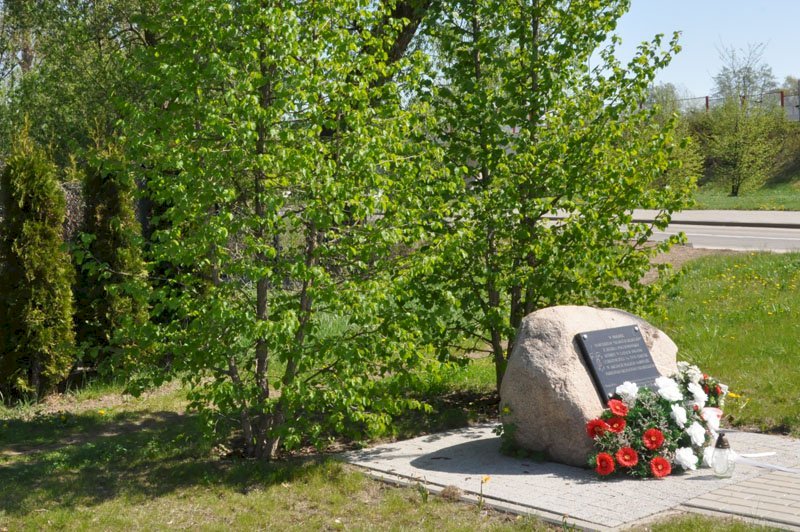
The memorial call to memory the teenage boys who took an active part in the minorsabotage operations against the Germans in Nazi-occupied Poland. They started underground resistance operations in 1943. They would place the red and white flags on the graves of Polish soldiers killed in 1939 and buried in the Wieliszew cemetery, they would distribute the underground press, paint the emblem of the Fighting Poland Movement and cover the operations conducted by the Polish Home Army soldiers. They often risked their lives, as during the sabotage operation of pouring sand into axle and oiling pad of the freight cars. When two scouts were arrested by the Germans, they risked the deportation to forced labour camps in Germany, or even death penalty. Thanks to the enormous efforts of many people, they were saved from the worst of concievable fates.
The inhabitants of Zegrze Południowe and the authorities of the Nieporęt commune paid tribute to the young and courageous scouts.

Today, in a converted casino building (No. 14) in Zegrze Południowe, there is the Library division of the Nieporęt commune. The events of 1917 are also commemorated by a memorial plaque.
Among the legionaries serving in Zegrze Południowe during the First World War, there have been many distinguished personalities. We can unquestionably name the outstanding poet Władysław Broniewski who, at the end of 1916, was transferred here along with the Polish 4th Legions Infantry Regiment. He was 19 years of age then and his literary success was yet to come. Under the pseudonym “Orlik” (‘Eagle’), Broniewski served in the Legions of April 1915, and along with the 4th Legions Infantry Regiment went through the terrible ordeal of battle.
After World War I, the cemetery served the Polish garrisons in Zegrze and Legionowo, as well as the local population. From this period comes the tombstone with the following inscription: Tadeusz Szczepanski, corporal of the 2nd Railway Engineer Regiment. He died tragically on August 15, 1927. To our beloved Son – Parents.
At the cemetery, on All Souls’ Day, a solemn roll call of the war dead is read by the soldiers.
Especially poignant are the graves of children from the 30s of the 20th century, mostly children of professional soldiers of the 2nd Railway Bridge Battalion and 2nd Balloon Battalion. In 1934, some of the ashes from the Wieliszew cemetery were transferred to the newly created Legionowo parish cemetery. In autumn 1944, the cemetery was on the front line of the Soviet-German skirmishes. Extremely heavy fighting in the area contributed to the most serious destruction to the tombstones.

In 1939, this officer, serving in the 67th Infantry Regiment, fought in the 4th Infantry Division “Pomerania”. He died heroically on September 14, 1939 in the Battle of the Bzura in the area between Chruślin Kościelny and Guźnia.
The plaque was unveiled in September 2011 on the pre-war property of Kazimierz Widort, which he had bought in 1937 from the Zyskowski family. On the three-hectare plot of land, he built the house where, in 1939, a few months before the war, he settled with his family. I In 1936, he married Halina Gidzińska and they settled together in Brodnica. However, Kazimierz Widort was temporarily moved to Warsaw, where he was a student of the 2nd Course of the Józef Piłsudski Central Institute of Physical Education in Bielany (today ‘AWF’, Józef Piłsudski University of Physical Education in Warsaw), and then boxing instructor and referee. He settled temporarily in Bielany, at 3, Podczaszyńskiego Street, and he commuted to Michalów, where he supervised the construction of the abovementioned house.
The commemorative plaque, funded by his son, Kornel Widort, was erected on the 72 anniversary of the death of the heroic officer.

The situation was as follows: The Poles won the battles of Stoczek, Dobre and Wawer, but the Russians commanded by the field marshal Dybicz, outnumbering the Polish troops by at least 2 to 1 or more, continued their march towards Warsaw district of Praga. And from the north, stretching from Nieporęt to Bialoleka, the Russian corps of General Szachowski marched ahead. The commander of Polish forces, General Józef Chłopicki ordered General Kazimierz Małachowski stationed in the village of Bialoleka to carry out reconnaissance mission and identify the corps. Colonel Antoni Jankowski having at his disposal a dozen squadrons of mounted riflemen, a battalion of line infantry and two horse artillery guns was sent out to reconnoitre the enemy. Early in the morning of February 24, Jankowski attacked the village of Nieporęt from the east, where the enemy with the unknown forces had its headquarters. He was probably counting on the fact that this is only an advance guard of the enemy corps. Unfortunately, he encountered the main Russian forces commanded by Szachowski. In response to the fire opened by the Polish troops, the Russians retaliated with a much fiercer attack, with strong cavalry units attacking from behind the buildings. The situation was redeemed by the commander of the grenadier company of the 6th Line Infantry Regiment, Captain Dobrzycki who stopped the Russian attack with a gun salvo, so that the Polish guns could be withdrawn into the woods. In this way he saved them from destruction. Jankowski, having seen the overwhelming forces of the enemy, ordered his troops to retreat.
This skirmish was the beginning of a fierce, all-day-long battle for Bialoleka. In the end General Małachowski ordered the withdrawal of his troops in the direction of Bródno, but he managed to effectively disorganize Russians’ battle plan of Praga district. Thanks to that he contributed to curtailing the Russian offensive at Olszynka Grochowska.

The village of Beniaminów became famous after the Oath Crisis, when the members of the Polish Legions who had refused to swear an oath of loyalty to the German Kaiser were interned there in July 1917 (the first prisoners came on July 22, 1917). Following the refusal to swear an oath of loyalty to the emperors of Germany and Austria- Hungary, by mid-August 1917, the total of 147 Polish Legion officers were interned in the barracks of Beniaminów. Later, in the interwar period and in exile, the formerly interned individuals became leading figures in political, social and military life. We shall name them here: last Prime Minister of the Second Polish Republic – Felicjan Slawoj Składkowski, heroic mayor of Warsaw – Stefan Starzyński, Minister of Post and Telegraphs – Ignacy Boerner, governor of Polesie – Wacław Kostka Biernacki, managing director of Polish Radio – Roman Starzyński, President of the Polish Bank – Adam Koc, commander of the Army “Pomerania” in the 1939 September Campaign – General Władysław Bortnowski, head of the Polish Military Mission in France – General Stanislaw Burhardt-Bukacki or commander of the Home Army – General Stefan Rowecki. The legend of the village of Beniaminów became a component inextricably linked to several biographies of generals and politicians of the Second Polish Republic.

On Wednesday, August 16, or as indicated by other sources, on Saturday, August 19th, 1944, 15 or 16 people were killed on the outskirts of Nowopol. In this tragedy among other, the following people perished: Rybarczyk (16 yrs), Jerzy Dymek (22 yrs), Edward Łaski (18 yrs), Jan Ląca (22 yrs), Stanisław Skarżycki (50 yrs), Janina Tomalska née Maciejewska, Janusz Pacho, Marian Walczak (23 yrs) – a hairdresser from Zegrze, Jerzy Sosnowski – a student from Warsaw, Józef Kozłowski from Łajski, Masłowski from Łajski, Aleksander Maciejewski – the brother of Janina Tomalska, Żak, Majewski and an unknown Russian.
Today, it is difficult to unambiguously determine the exact date of those tragic events, because in that period, the surrounding villages witnessed numerous arrest scenes and executions of civilians and the Polish Home Army soldiers
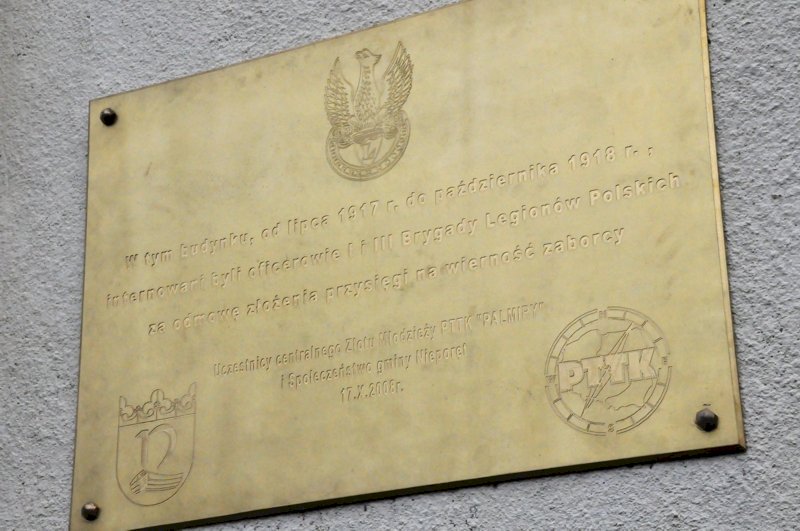
The buildings in which the Polish officers were interned, after World War II were extended upwards and plastered, but they still bear many of the characteristics of the Tsarist garrison buildings. They can be distinguished by the continuous footing made of granite blocks, semi-circular lintels above the window openings and corner rustication. In the building No. 13, on which a commemorative plaque was suspended, the German command of the camp was located. Here were the offices of the commanders, of captain Cleinow and second lieutenant Ebner, among others. In the adjacent building, now under the No. 17, the famous editorial of the “Beniaminów Bulletin” was located, periodical edited by the detained legionnaire, second lieutenant Roman Starzyński, Chief Executive of the Polish Radio in the 30s of the 20th century. In the building currently occupied by the Kindergarten No. 32, from 22 July 1917 until 27 March 1918, the captain and doctor Felicjan Sławoj Składkowski was interned, who later became Divisional General and the Prime Minister of the Republic of Poland in the years 1936-1939.

The prisoners originally lived in dugouts, and then in barracks. As a result of the inhuman living conditions in the camp, at least 10 thousand Soviet prisoners of various nationalities have died. The causes of death were numerous: epidemics, especially typhus, starvation, beatings, and forced hard labour in the camp subsidiaries in Poniatów, Buków and in the Legionowo barracks. According to the testimony of the residents of Białobrzegi, submitted in 1948, before the main Commission for the Investigation of Nazi Crimes in Poland, the famine forced prisoners to eat grass. The cases of cannibalism have also been reported. Attempts to provide assistance to the prisoners by the local people were punishable by death. In autumn 1943, the German guard executed Genowefa Wróbel for throwing food over the barbed wire to the prisoners. The guards of the camp consisted of older men, considered physically unfit for frontline service of German companies of the 614. National Rifle Battalion.
According to the incomplete German records, in 1942 there were 6,378 prisoners of war in the camp, while in the autumn of 1943; there were 2,114 Soviet prisoners of war and 2,720 Italian POWs.
On July 28, 1944, shortly before the outbreak of the Warsaw Uprising, the prisoner-of-war camp in Beniaminów was liberated by the Home Army sub-unit of the Third Battalion from Nieporęt, commanded by first lieutenant Zygmunt Mirecki alias ‘Zim’.
With the efforts of the Historical Society of Nieporęt, three tombstones to commemorate the Italian prisoners of war who died in 1944 were laid to rest in the cemetery.

The Tsarist period of the fort in Beniaminów ends on August 10, 1915, when German troops captured it. Before the withdrawal, the Russians managed to blow up the main defence elements.
The fort in Beniaminów played an important military role in the Polish-Soviet War and especially during the Battle of Warsaw in mid-August 1920. It served as the second line of defence of Warsaw (the so-called ‘former German defence line’) before the advancing Bolshevik troops. The soldiers of the 48th Rifle Borderland Infantry Regiment heroically defended the fortifications. On August 14, 1920, the Bolsheviks drove a wedge between Radzymin and Beniaminów, occupying the nearby villages of Dąbkowizna and Wolka Radzymińska. On the night of 14th to 15th August 1920, the Soviets attempted twice to break into the fort. During the fighting, both sides suffered heavy losses. 10 Poles were killed and 23 soldiers were wounded. But they managed to capture a machine gun and took 26 Russian prisoners from three regiments: 241st Peasants Rifle Regiment commanded by Tierentiew, 243rd Petrograd Rifle Regiment ‘Uvarov’ (both belonging to the 81st Rifle Brigade of combrig Stepanov) and the 189th Rifle Regiment (21st Rifle Division of Ivan Smolin).

- pilot officer Władysław Kołdej - born on 7 July 1915, graduate of the Pilot Officer Cadet School in Dęblin (11th promotion), after being promoted to the rank of pilot officer on 15.10.1938, was assigned to the 1st Aviation Regiment and took part in the campaign of September 1939 as a spotter pilot of the 16th Polish Bomber Squadron fighting as part of the Bomber Brigade. On the 7th of September 1939, at 15.45, he took off from the Popielewo airport as the crew commander on board the PZL.37B Moose (“Łoś”) bomber and did not return from this sortie.
- pilot officer cadet Wacław Cierpiłowski – born on 23 November 1915 in Lida, graduate of the Pilot Officer Cadet School in Dęblin, in June 1939 assigned for practice to the 1st Aviation Regiment, took part in the campaign of September 1939 as a pilot of the 16th Polish “Moose” Bomber Squadron. On the 7th of September 1939, at 15.45, he took off from the Popielewo airport as the pilot on board the PZL.37B Moose bomber and did not return from this sortie;
- leading aircraftman shooter Karol Pysiewicz– born on 19 July 1917, graduate of the Polish Air Force N.C.O.’s Training School in Bydgoszcz, assigned to the 1st Aviation Regiment, took part in the campaign of September 1939 as a shooter of the 16th Polish “Moose” Bomber Squadron. On the 7th of September 1939, at 15.45, he took off from the Popielewo airport as the shooter on board the PZL.37B Moose bomber and did not return from this sortie;
- leading aircraftman shooter Kazimierz Wielgoszewski – born on 4 August 1919, graduate of the Polish Air Force N.C.O.’s Training School in Bydgoszcz, assigned to the 1st Aviation Regiment, took part in the campaign of September 1939 as a shooter of the 16th Polish “Moose” Bomber Squadron, fighting as part of the Polish Bomber Brigade. On the 7th of September 1939, at 15.45, he took off from the Popielewo airport as the shooter on board the PZL.37B Moose bomber and did not return from this sortie.
During Autumn 2011, the place of the plane crash was discovered and confirmed by the excavations of large pieces of the aircraft. In order to commemorate this tragic event the territorial government authorities and the inhabitants of the Nieporęt commune founded the memorial monument. It is in the form of a granite plaque of irregular shape with a 1:1 replica of the propeller of the PZL.37B Moose plane.

On the night of 14 to 15 August the Soviet army was planning to block and destroy radio contact of the Polish troops on the right bank of the Vistula River. The Polish troops who departed from the rallying point in the Legionowo barracks and were temporarily stationed in the vicinity of Alexandrów, at the high command’s behest, daringly attacked the Soviet army. By the attack in the direction of Wolka Radzymińska, the 28th Kaniów Rifle Regiment engaged in battle the enemy’s superior forces, thusly preventing the Soviet troops’ plans. Lieutenant Pogonowski’s units captured the Wólka Radzymińska district. It was the first decisive victory of the Polish troops at this stage of the war. According to General Lucjan Żeligowski, the attack of Lieutenant Pogonowski’s troops was a turning point in the Battle of Warsaw and, as a result, of the Polish-Soviet War.
This important victory was attained at the cost of lives of Lieutenant Stefan Pogonowski, who was killed when leading a charge of a battalion he commanded, of the cost of the 6th ‘Benedykt Pęczkowski’ company and of 18 soldiers who fell fighting for their country in the morning of August 15, 1920. In recognition of their heroism on the battlefield, both commanders were posthumously promoted to the rank of Captains.
In 1924, in nearby Zamostki Wólczyńskie, the President of the Second Republic of Poland Stanisław Wojciechowski unveiled an obelisk commemorating the soldiers of the 28th Kaniów Rifle Regiment who fell fighting for their country on August 15, 1920 (see item 27).
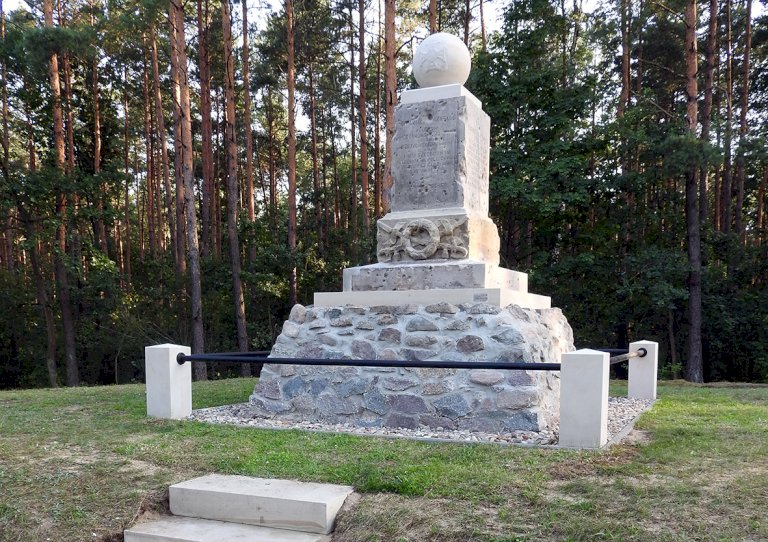
The inscription on the monument commemorates Captain Stefan Pogonowski – commander of the 1st battalion of the 28th Kaniowski Rifle Regiment, Captain Benedykt Pęczkowski – commander of the 6th company and 18 soldiers fallen in the morning of August 15, 1920.
The battalion commanded by the captain Pogonowski was directed to Radzymin due to a meeting of three generals, important for the course of the Battle of Warsaw. In the afternoon of August 14, 1920, in Legionowo barracks, General Józef Haller, commander of the Polish Northern Front, met commander of the 1st Army, General Franciszek Latinik and General Lucjan Żeligowski, commander of the 10th Infantry Division which was stationed here. It was then established that the 10th Infantry Division (together with the 28th Kaniowski Rifle Regiment) would not be directed to Modlin, as previously planned, but would proceed to recapture Radzymin from the hands of the Russians.
The task was executed gradually, and the soldiers who died in the line of duty were honoured by their regiment in the cemetery of Radzymin and commemorated with a sandstone monument in Zamostki. The cycling route commemorating the second line of defence and dedicated to Captain S. Pogonowski runs close to the monument.

